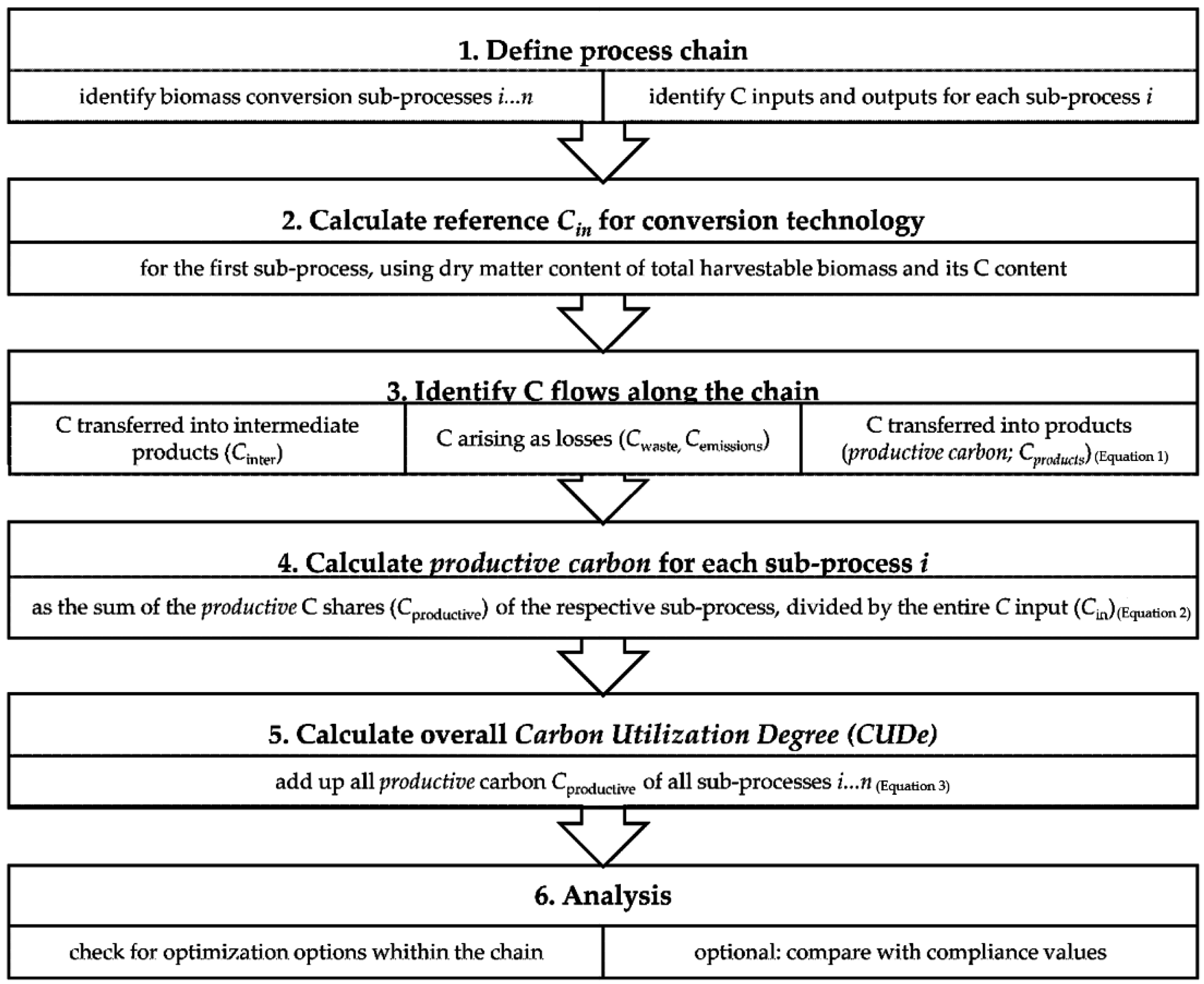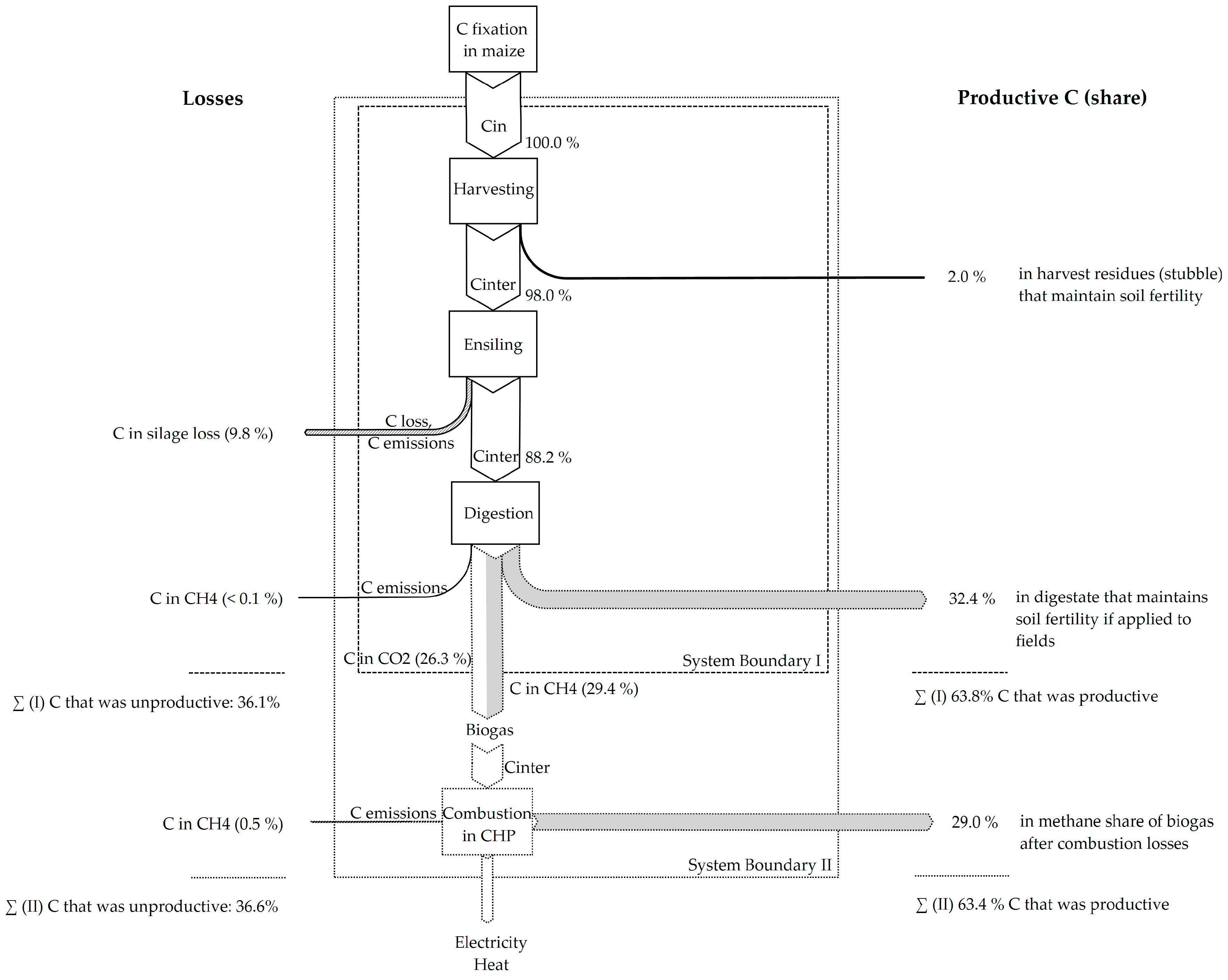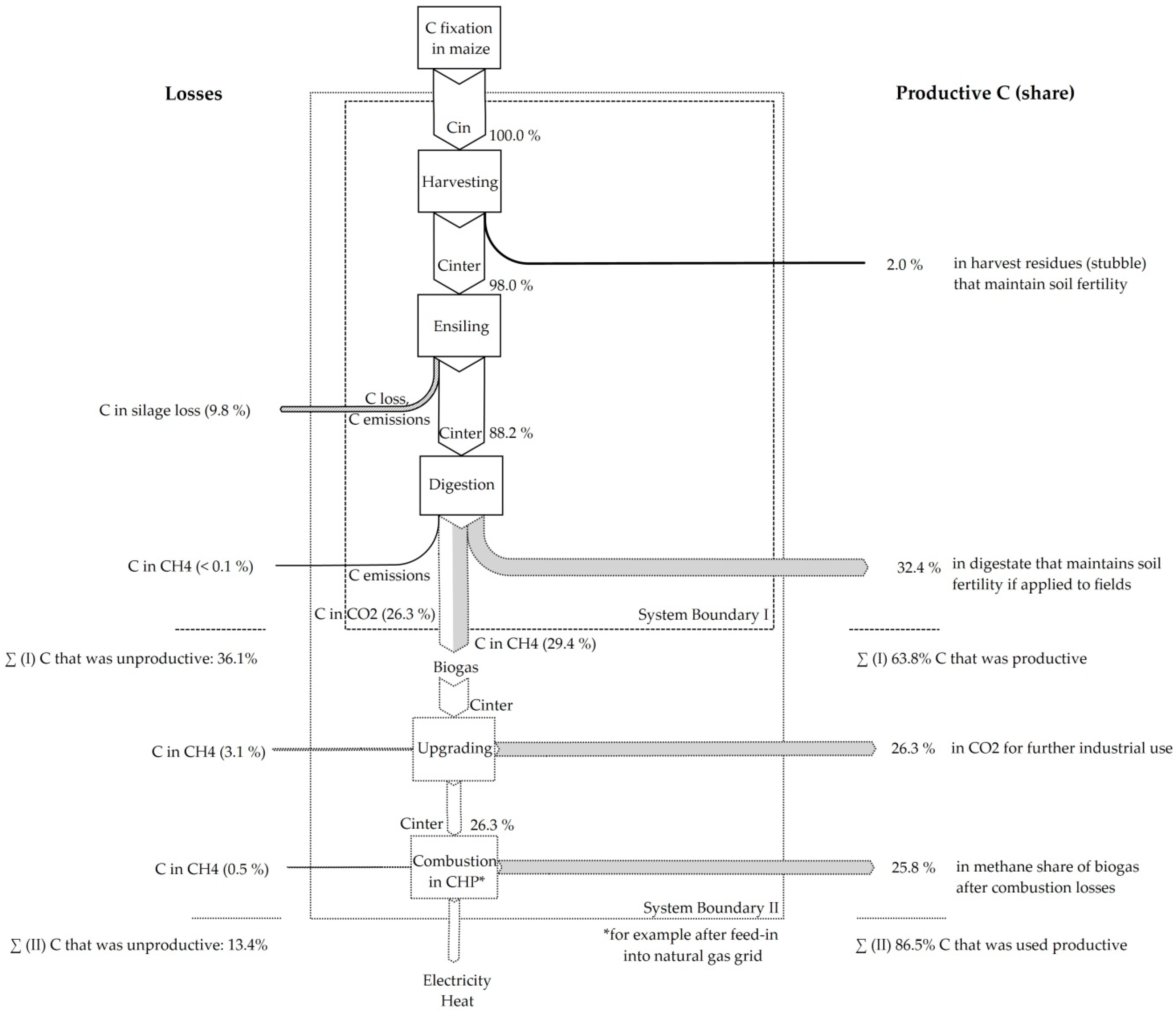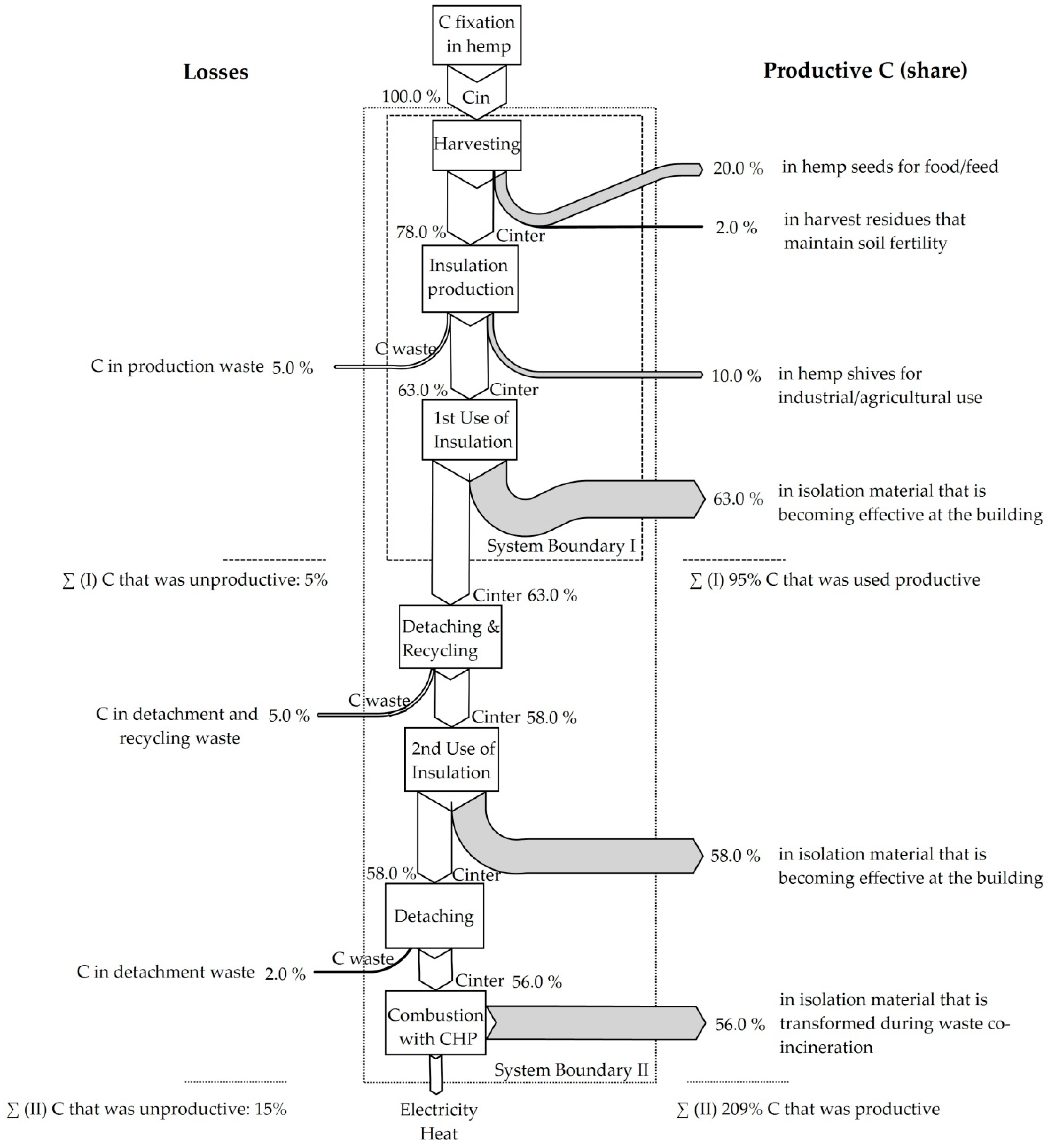CUDe—Carbon Utilization Degree as an Indicator for Sustainable Biomass Use
Abstract
:1. Introduction
- as carbohydrates and fats in food and feed,
- as hydrocarbons in energy carriers and
- as bulk chemicals for the chemical industry.
- to extend the perception of C (and accordingly CO2) from having a negative impact to being an indispensable, limited resource and
- to provide a supplementary indicator for policy decision support to express efficient C use in production chains.
2. The Carbon Utilization Degree Approach
- is transformed into marketable products or provides useful services, e.g., insulation material, forage or energy generation (direct benefit), or
- performs important ecological functions, e.g., improves soil fertility (indirect benefit).
3. Example Application
3.1. Carbon Utilization Degree of a Biomass Transformation to Bioenergy—Anaerobically Digested Maize
3.2. Carbon Utilization Degree of a Biomass Material Usage—Hemp Fibers as Insulation Material
4. Discussion of the Approach
4.1. Impact-Oriented Approaches vs. Resource-Use-Oriented Approaches for Policy Decision Support
4.2. Boundaries, Time Frames, and Carbon Sequestration
5. Conclusions and Outlook
Acknowledgments
Author Contributions
Conflicts of Interest
Abbreviations
| C | Carbon |
| CF | Characterization factor |
| CH4 | Methane |
| CHP | Combined Heat and Power |
| Cemissions | Carbon in gaseous losses, e.g., in CO2 or CH4 |
| Cin | Carbon content in biomass dry matter that enters the biomass conversion chain |
| Cinter | Carbon in intermediate products |
| CO2 | Carbon dioxide |
| Cproductive | Carbon that becomes productive in a wide anthropocentric view |
| Cproducts | Carbon in final products and co-products |
| CSF | Carbon Stability Factor |
| CUDe | Carbon Utilization Degree [%] |
| Cwaste | Carbon in waste, e.g., in production waste |
| EU ETS | European Union Emissions Trading System |
| GDP | Gross Domestic Product |
| GHG | Greenhouse Gas(es) |
| GWP | Global Warming Potential(s) |
| L. | Carl von Linné (botanical author citation) |
| LCA | Life Cycle Assessment |
| MACC | Marginal Abatement Cost Curves |
| NPP | Net Primary Production |
| NEP | Net Ecosystem Production |
Appendix A
| Name | NPP/NEP | Carbon Productivity | Carbon Intensity | C Balance | MACC | S&P/IFCI Carbon Efficient Index | CSF | Carbon Efficiency | CUDe |
|---|---|---|---|---|---|---|---|---|---|
| Denominator | Unit of area and unit of time | Unit of emitted CO2a per period per country | Unit of sales | Unit of mitigated CO2e | Unit of C in fresh biochar | Total C present in reactants | Carbon fixed in harvestable biomass | ||
| Numerator | Unit of generated energy (or biomass) | Unit of the specific value of GDP in the same period | C emissions | Unit of cost of a technology | Unit of biochar C after 100 years | Amount of C in product × 100 | Productive C | ||
| Unit | g·C·m−2·year−1 | Currency kg−1 CO2 emitted | kg C emitted/unit of sales $ | % | Currency t−1 CO2e mitigated | Dimensionless or % | % | % | |
| Baseline | Usually one year | Arbitrary period length, often one year | Marginal cost and projected emissions of reference technology | 100 years | Not stated | Adjustable | |||
| Description | Rate at which energy is converted into biomass | Used in economics; reciprocal of carbon emission intensity per unit of GDP b; “Reflects economic benefits yielding from per unit of CO2 emission” c | “A MAC curve is a graph that indicates the marginal cost (the cost of the last unit) of emission abatement for varying amounts of emission reduction.” d | Remaining C in carbonized biomass (biochar) after labile and instable fractions are released | Ratio of productive C to initial Cin in the biomass | ||||
| Target audience | Science | Policy | Policy | Science | Pharmaceutical industry | Policy | |||
| Methodology | 1. Measure biomass production (for example: destructive measurements/NPP; flux measurements/NEP; models) 2. Convert biomass dry matter according to C contents | 1. Define period 2. Look up GDP and fossil resource use for that period 3. Calculate CO2 emissions from resource use via emission factors | 1. Define baselines (emissions in target year; technology) 2. Identify and describe possible abatement technologies and their costs for the target year 3. Plot abatement potentials on x-axis and costs per ton on y-axis | 1. Measure C content in fresh biochar 2. Identify labile (after a few weeks) and instable (e.g., via accelerated ageing methods) C shares in original biochar | Please refer to Scheme 1 | ||||
| Benefits | In combination with modelling approaches, shortcomings (see below) can be overcome. | Comparison of different nations possible Different development stages visible | Comparison of different nations possible Illustrative tool to present mitigation options | Intuitive to understand Reflects C sequestration Percentages in different products in multi-product systems can be summed up. | Simplified formula takes into account the stoichiometry of reactants and products of interest to the pharmaceutical industry where the development of carbon skeletons is key to their work. | Paradigm change to carbon being an asset of the bio-economy instead of a threat Reflects the C use efficiency of the conversion process | |||
| Shortcomings | Representativeness for analyzed biomes and attributed area critical Accounting for land use change | Only fossil CO2 (no other GHG included, for example, nitrous oxide, CH4) Inherent connection to economic cycle and growth paradigm | Static representation of costs for single years; no allocation of costs to ancillary benefits of GHG mitigation; lack of transparency; poor treatment of uncertainty, inter-temporal dynamics, interactions between sectors (see details in d) | No additional necessary C for conversion processes considered CSF uncertain due to the wide range of assumed residence times of C remaining in the biochar after application to soils (293–9259 years e) | No complete GHG assessment (only CO2 and CH4 included) CUDe is not directly related to output quantity No energy-related C input considered | ||||
| References | [64] | [6] c, [23] b, [65] a. a uses CO2 equivalents as a basis. | Only sparse information given in [66] | [67] | [68], [69] d | [70] | [62] e, [71,72] | Acc. to [73] developed at GlaxoSmithKline (GSK); no original source available | This manuscript |
References
- Brock, T.D.; Madigan, M.T.; Martinko, J.M.; Parker, J. Biology of Microorganisms: (1994): Biology of Microorganisms, 7th ed.; Prentice Hall International: Englewood Cliffs, NJ, USA; London, UK, 1994; p. 909. [Google Scholar]
- KTBL. Energiepflanzen—Daten für die Planung des Energiepflanzenanbaus; KTBL Kuratorium für Technik und Bauwesen in der Landwirtschaft: Darmstadt, Germany, 2006. [Google Scholar]
- Reisinger, K.; Haslinger, C.; Herger, M.; Hofbauer, H. BIOBIB—A Database for Biofuels. Available online: http://cdmaster2.vt.tuwien.ac.at/biobib/sd112.html (accessed on 11 September 2014).
- Romanova, N.D.; Sazhin, A.F. Relationships between the cell volume and the carbon content of bacteria. Oceanology 2010, 50, 522–530. [Google Scholar] [CrossRef]
- Bi, Z.; He, B.B. Characterization of Microalgae for the Purpose of Biofuel Production. Trans. ASABE 2013. [Google Scholar] [CrossRef]
- Jiankun, H.; Mingshan, S. Carbon Productivity Analysis to Address Global Climate Change. Chin. J. Popul. Resour. Environ. 2011, 9, 9–15. [Google Scholar] [CrossRef]
- Nova-Institut für Politische und Ökologische Innovation GmbH. 5th Conference on Carbon Dioxide as Feedstock for Fuels, Chemistry and Polymers. Available online: http://co2-chemistry.eu/ (accessed on 12 October 2016).
- Liu, Q.; Wu, L.; Jackstell, R.; Beller, M. Using carbon dioxide as a building block in organic synthesis. Nat. Commun. 2015, 6, 5933. [Google Scholar] [CrossRef] [PubMed]
- Kortlever, R.; Shen, J.; Schouten, K.J.P.; Calle-Vallejo, F.; Koper, M.T.M. Catalysts and Reaction Pathways for the Electrochemical Reduction of Carbon Dioxide. J. Phys. Chem. Lett. 2015, 6, 4073–4082. [Google Scholar] [CrossRef] [PubMed]
- Park, S.-E. Editorial. J. CO2 Util. 2013, 1, 3. [Google Scholar] [CrossRef] [PubMed]
- Science Direct. Online Search, Search Term in Journals: “Low Carbon”. 2016. Available online: http://www.sciencedirect.com/ (accessed on 31 May 2016).
- Bosch, R.; van de Pol, M.; Philp, J. Policy: Define biomass sustainability. Nature 2015, 523, 526–527. [Google Scholar] [CrossRef] [PubMed]
- Koskela, S.; Mattila, T.; Antikainen, R.; Mäenpää, I. Identifying Key Sectors and Measures for a Transition towards a Low Resource Economy. Resources 2013, 2, 151–166. [Google Scholar] [CrossRef]
- Cherubini, F.; Strømman, A.H. Life cycle assessment of bioenergy systems: State of the art and future challenges. Bioresour. Technol. 2011, 102, 437–451. [Google Scholar] [CrossRef] [PubMed]
- Searchinger, T.D.; Hamburg, S.P.; Melillo, J.; Chameides, W.; Havlik, P.; Kammen, D.M.; Likens, G.E.; Lubowski, R.N.; Obersteiner, M.; Oppenheimer, M.; et al. Climate change. Fixing a critical climate accounting error. Science 2009, 326, 527–528. [Google Scholar] [CrossRef] [PubMed]
- Taheripour, F.; Hertel, T.W.; Tyner, W.E.; Beckman, J.F.; Birur, D.K. Biofuels and their by-products: Global economic and environmental implications. Biomass Bioenergy 2010, 34, 278–289. [Google Scholar] [CrossRef]
- Rabl, A.; Benoist, A.; Dron, D.; Peuportier, B.; Spadaro, J.V.; Zoughaib, A. How to account for CO2 emissions from biomass in an LCA. Int. J. Life Cycle Assess. 2007, 12, 281. [Google Scholar] [CrossRef]
- Greenhouse Gas Protocol. Global Warming Potential Values, Adapted from IPCC Fifth Assessment Report (AR5). 2014. Available online: http://ghgprotocol.org/sites/default/files/ghgp/Global-Warming-Potential-Values%20(Feb%2016%202016).pdf (accessed on 8 June 2016).
- Ott, K.; Thapa, P.P. Greifswald’s Environmental Ethics, from the Work of the Michael Otto Professorship at Ernst Moritz Arndt University 1997–2002; Steinbecker: Greifswald, Germany, 2003; Available online: https://doi.org/10.13140/2.1.2435.3604 (accessed on 31 May 2016).
- Hill, B. An Introduction to Economics: Concepts for Students of Agriculture and the Rural Sector, 4th ed.; CABI: Oxfordshire, UK, 2014. [Google Scholar]
- Jackson, T. Least-cost greenhouse planning supply curves for global warming abatement. Energy Policy 1991, 19, 35–46. [Google Scholar] [CrossRef]
- Yang, H. Carbon Efficiency, Carbon Reduction Potential, and Economic Development in the People’s Republic of China, a Total Factor Production Model. 2010. Available online: http://www.adb.org/sites/default/files/publication/27499/carbon-efficiency-prc.pdf (accessed on 13 January 2016).
- Kaya, Y.; Yokobori, K. Environment, Energy and Economy: Strategies for Sustainability; Bookwell Publications: Delhi, India, 1999. [Google Scholar]
- Wang, P.-C.; Lee, Y.-M.; Chen, C.-Y. Estimation of Resource Productivity and Efficiency: An Extended Evaluation of Sustainability Related to Material Flow. Sustainability 2014, 6, 6070–6087. [Google Scholar] [CrossRef]
- Ellen MacArthur Foundation; Granta Material Intelligence. Circularity Indicators, an Approach to Measuring Circularity. Methodology. 2015. Available online: https://www.ellenmacarthurfoundation.org/assets/downloads/insight/Circularity-Indicators_Methodology_May2015.pdf (accessed on 21 June 2016).
- Kallis, G.; Kalush, M.; O’Flynn, H.; Rossiter, J.; Ashford, N. “Friday off”: Reducing Working Hours in Europe. Sustainability 2013, 5, 1545–1567. [Google Scholar] [CrossRef]
- Ecoinvent Centre. Ecoinvent Data. Available online: www.ecoinvent.org (accessed on 11 September 2014).
- De Lucia, M.; Assennato, D. Agricultural Engineering in Development: Post-Harvest Operations and Management of Foodgrains; Food and Agriculture Organizations of the United Nations: Rome, Italy, 1994. [Google Scholar]
- Carus, M.; Raschka, A.; Fehrenbach, H.; Rettenmaier, N.; Dammer, L.; Köppen, S.; Thöne, M.; Dobroschke, S.; Diekmann, L.; Hermann, A.; et al. Environmental Innovation Policy—Greater Resource Efficiency and Climate Protection through the Sustainable Material Use of Biomass, Short Version. 2014. Available online: https://www.umweltbundesamt.de/sites/default/files/medien/378/publikationen/texte_03_2014_druckfassung_uba_stofflich_abschlussbericht_kurz_englisch.pdf (accessed on 11 July 2016).
- Meyer-Aurich, A.; Schattauer, A.; Hellebrand, H.J.; Klauss, H.; Plöchl, M.; Berg, W. Impact of uncertainties on greenhouse gas mitigation potential of biogas production from agricultural resources. Renew. Energy 2012, 37, 277–284. [Google Scholar] [CrossRef]
- Zhang, W.; Liu, K.; Wang, J.; Shao, X.; Xu, M.; Li, J.; Wang, X.; Murphy, D.V. Relative contribution of maize and external manure amendment to soil carbon sequestration in a long-term intensive maize cropping system. Sci. Rep. 2015, 5, 10791. [Google Scholar] [CrossRef] [PubMed]
- Herrmann, C.; Heiermann, M.; Idler, C. Effects of ensiling, silage additives and storage period on methane formation of biogas crops. Bioresour. Technol. 2011, 102, 5153–5161. [Google Scholar] [CrossRef] [PubMed]
- Murphy, J.; Braun, R.; Weiland, P.; Wellinger, A. Biogas from Crop Digestion. Available online: http://www.iea-biogas.net/files/daten-redaktion/download/publi-task37/Biogas%20from%20Crops_2011_Final.pdf (accessed on 13 June 2016).
- Liebetrau, J.; Reinelt, T.; Clemens, J.; Hafermann, C.; Friehe, J.; Weiland, P. Analysis of greenhouse gas emissions from 10 biogas plants within the agricultural sector. Water Sci. Technol. 2013, 67, 1370–1379. [Google Scholar] [CrossRef] [PubMed]
- Al Seadi, T.; Lukehurst, C.T. Quality Management of Digestate from Biogas Plants Used as Fertiliser. 2012. Available online: http://www.iea-biogas.net/files/daten-redaktion/download/publi-task37/digestate_quality_web_new.pdf (accessed on 9 June 2016).
- Persson, M.; Jonsson, O.; Wellinger, A. Biogas Upgrading to Vehicle Fuel Standards and Grid Injection. 2006. Available online: http://www.iea-biogas.net/files/daten-redaktion/download/publi-task37/upgrading_report_final.pdf (accessed on 9 June 2016).
- Aschmann, V.; Effenberger, M.; Gronauer, A. Kohlenwasserstoffverbindungen im Abgas biogasbetriebener Blockheizkraftwerke. Landtechnik 2010, 65, 338–341. [Google Scholar]
- Fachagentur Nachwachsende Rohstoffe e. V. (FNR). Biogasaufbereitung (Biogas Upgrading). 2013. Available online: http://biogas.fnr.de/biogas-gewinnung/anlagentechnik/biogasaufbereitung/ (accessed on 9 June 2016).
- Chery, D.; Lair, V.; Cassir, M. Overview on CO2 Valorization: Challenge of Molten Carbonates. Front. Energy Res. 2015, 3, 5546. [Google Scholar] [CrossRef]
- Götz, M.; Lefebvre, J.; Mörs, F.; McDaniel Koch, A.; Graf, F.; Bajohr, S.; Reimert, R.; Kolb, T. Renewable Power-to-Gas: A technological and economic review. Renew. Energy 2016, 85, 1371–1390. [Google Scholar] [CrossRef]
- Goulder, L.H.; Schein, A. Carbon taxes versus cap and trade: A critical review. Clim. Chang. Econ. 2013, 4, 1350010. [Google Scholar] [CrossRef]
- European Commission. The EU Emissions Trading System (EU ETS). 2016. Available online: http://ec.europa.eu/clima/policies/ets/index_en.htm (accessed on 2 February 2016).
- Searchinger, T.D. Biofuels and the need for additional carbon. Environ. Res. Lett. 2010, 5, 024007. [Google Scholar] [CrossRef]
- Smith, K.A.; Searchinger, T.D. Crop-based biofuels and associated environmental concerns. Glob. Chang. Biol. Bioenergy 2012, 4, 479–484. [Google Scholar] [CrossRef]
- Van Loo, S.; Koppejan, J. The Handbook of Biomass Combustion and Co-Firing, 2nd ed.; Earthscan: London, UK, 2008. [Google Scholar]
- European Commission. A Policy Framework for Climate and Energy in the Period from 2020 to 2030. 2014. Available online: http://eur-lex.europa.eu/legal-content/EN/TXT/PDF/?uri=CELEX:52014DC0015&from=EN (accessed on 9 June 2016).
- European Commission. Climate Action Progress Report 2015, Including the Report on the Functioning of the European Carbon Market and the Report on the Review of Directive 2009/31/EC on the Geological Storage of Carbon Dioxide. Available online: http://ec.europa.eu/clima/policies/strategies/progress/docs/progress_report_2015_en.pdf (accessed on 9 June 2016).
- Pansera, M.; Sarkar, S. Crafting Sustainable Development Solutions: Frugal Innovations of Grassroots Entrepreneurs. Sustainability 2016, 8, 51. [Google Scholar] [CrossRef]
- G7. Leaders’ Declaration G7 Summit, 7–8 June 2015. Available online: https://sustainabledevelopment.un.org/content/documents/7320LEADERS%20STATEMENT_FINAL_CLEAN.pdf (accessed on 11 July 2016).
- European Council. European Council Meeting (23 and 24 October 2014), Conclusions. 2014. Available online: http://www.consilium.europa.eu/uedocs/cms_data/docs/pressdata/en/ec/145397.pdf (accessed on 11 July 2016).
- Lehtonen, M.; Sébastien, L.; Bauler, T. The multiple roles of sustainability indicators in informational governance: Between intended use and unanticipated influence. Curr. Opin. Environ. Sustain. 2016, 18, 1–9. [Google Scholar] [CrossRef]
- Runhaar, H. Tools for integrating environmental objectives into policy and practice: What works where? Environ. Impact Assess. Rev. 2016, 59, 1–9. [Google Scholar] [CrossRef]
- Jakob, M.; Edenhofer, O. Green growth, degrowth, and the commons. Oxf. Rev. Econ. Policy 2015, 30, 447–468. [Google Scholar] [CrossRef]
- Geels, F.W.; Berkhout, F.; van Vuuren, D.P. Bridging analytical approaches for low-carbon transitions. Nat. Clim. Chang. 2016, 6, 576–583. [Google Scholar] [CrossRef]
- Robergé, J.-M.; Angelstam, P.E. Usefulness of the Umbrella Species Concept as a Conservation Tool. Conserv. Biol. 2004, 18, 76–85. [Google Scholar] [CrossRef]
- International Organization for Standardization. ISO 14040. Environmental Management—Life Cycle Assessment—Principles and Framework; Beuth Verlag: Berlin, Germany, 2006. [Google Scholar]
- International Organization for Standardization. ISO 14044. Environmental Management—Life Cycle Assessment—Requirements and Guidelines; Beuth Verlag: Berlin, Germany, 2006. [Google Scholar]
- Hansen, A.; Budde, J.; Prochnow, A. Resource Usage Strategies and Trade-Offs between Cropland Demand, Fossil Fuel Consumption, and Greenhouse Gas Emissions—Building Insulation as an Example. Sustainability 2016, 8, 613. [Google Scholar] [CrossRef]
- Melin, Y.; Petersson, H.; Egnell, G. Assessing carbon balance trade-offs between bioenergy and carbon sequestration of stumps at varying time scales and harvest intensities. For. Ecol. Manag. 2010, 260, 536–542. [Google Scholar] [CrossRef]
- Mantau, U. Wood flow analysis: Quantification of resource potentials, cascades and carbon effects. Biomass Bioenergy 2015, 79, 28–38. [Google Scholar] [CrossRef]
- Verein Deutscher Ingenieure (VDI). Cumulative Energy Demand (KEA)—Terms, Definitions, Methods of Calculation; Beuth Verlag: Berlin, Germany, 2012. [Google Scholar]
- Hammond, J.; Shackley, S.; Sohi, S.; Brownsort, P. Prospective life cycle carbon abatement for pyrolysis biochar systems in the UK. Energy Policy 2011, 39, 2646–2655. [Google Scholar] [CrossRef]
- Intergovernmental Panel on Climate Change (IPCC). Contribution of Working Group I to the Fourth Assessment Report of the Intergovernmental Panel on Climate Change: “The Physical Science Basis”; Solomon, S., Qin, D., Manning, M., Chen, Z., Marquis, M., Averyt, K.B., Tignor, M., Miller, H.L., Eds.; Cambridge University Press: Cambridge, UK; New York, NY, USA, 2007. [Google Scholar]
- Roy, J.; Saugier, B. Terrestrial Primary Productivity. In Terrestrial Global Productivity; Elsevier: Amsterdam, The Netherlands, 2001; pp. 1–6. [Google Scholar]
- McKinsey Global Institute. The Carbon Productivity Challenge: Curbing Climate Change and Sustaining Economic Growth; McKinsey & Company: New York, NY, USA, 2008. [Google Scholar]
- Cazalet, W.; Wong, K.Q. Green Beta: Carbon Efficiency Investing. 2015. Available online: https://www.bnymellon.com/_global-assets/pdf/our-thinking/business-insights/green-beta-carbon-efficiency-investing.pdf (accessed on 15 March 2016).
- AVA-CO2. Technology, Hydrothermal Carbonisation (HTC). 2016. Available online: http://www.ava-CO2.com/web/pages/en/technology/hydrothermal-carbonization.php (accessed on 15 March 2016).
- Enkvist, P.-A.; Nauclér, T.; Rosander, J.A. A cost curve for greenhouse gas reduction: A global study of the size and cost of measures to reduce greenhouse gas emissions yields important insights for businesses and policy makers. McKinsey Quat. 2007, 35–45. [Google Scholar]
- Kesicki, F.; Ekins, P. Marginal abatement cost curves: A call for caution. Clim. Policy 2012, 12, 219–236. [Google Scholar] [CrossRef]
- S&P Dow Jones Indices. S&P/IFCI Carbon Efficient Index, Methodology. 2016. Available online: http://www.ifc.org/wps/wcm/connect/4e600a8048855921820cd26a6515bb18/Factsheet_SP_IFCI_Carbon_Efficient_Index.pdf?MOD=AJPERES (accessed on 15 March 2016).
- Guest, G.; Bright, R.M.; Cherubini, F.; Strømman, A.H. Consistent quantification of climate impacts due to biogenic carbon storage across a range of bio-product systems. Environ. Impact Assess. Rev. 2013, 43, 21–30. [Google Scholar] [CrossRef]
- Shackley, S.; Carter, S.; Knowles, T.; Middelink, E.; Haefele, S.; Haszeldine, S. Sustainable gasification—Biochar systems? A case-study of rice-husk gasification in Cambodia, Part II: Field trial results, carbon abatement, economic assessment and conclusions. Energy Policy 2012, 41, 618–623. [Google Scholar] [CrossRef]
- Boodhoo, K.; Harvey, A. Process Intensification Technologies for Green Chemistry: Engineering Solutions for Sustainable Chemical Processing; Wiley: Hoboken, NJ, USA, 2013. [Google Scholar]




| Organism | Mean Carbon Content (% of Dry Matter) | Range | Reference |
|---|---|---|---|
| Overall mean of energy crops | 46.5 | [2] | |
| Maize (Zea mays L.) (whole plant) | 48.6 | 47–50.2 | [2] |
| Poplar (Populus spec.) (in wood) | 47.5 | [2] | |
| Willow (Salix spec.) (in wood) | 47.1 | [2] | |
| Wheat (Triticum L.) (whole plant) | 45.2 | [2] | |
| Rye (Secale cereale L.) (whole plant) | 48.0 | [2] | |
| Grasses | 43.9 | 41.4–46.4 | [2] |
| Hemp (Cannabis L.) | 45.12 | [3] | |
| Bacteria | ≈50 | [4] | |
| Microalgae (green/brown) | 54.4/24.7 | 49–58/24–25 | [5] |
© 2016 by the authors; licensee MDPI, Basel, Switzerland. This article is an open access article distributed under the terms and conditions of the Creative Commons Attribution (CC-BY) license (http://creativecommons.org/licenses/by/4.0/).
Share and Cite
Hansen, A.; Budde, J.; Karatay, Y.N.; Prochnow, A. CUDe—Carbon Utilization Degree as an Indicator for Sustainable Biomass Use. Sustainability 2016, 8, 1028. https://doi.org/10.3390/su8101028
Hansen A, Budde J, Karatay YN, Prochnow A. CUDe—Carbon Utilization Degree as an Indicator for Sustainable Biomass Use. Sustainability. 2016; 8(10):1028. https://doi.org/10.3390/su8101028
Chicago/Turabian StyleHansen, Anja, Jörn Budde, Yusuf Nadi Karatay, and Annette Prochnow. 2016. "CUDe—Carbon Utilization Degree as an Indicator for Sustainable Biomass Use" Sustainability 8, no. 10: 1028. https://doi.org/10.3390/su8101028






